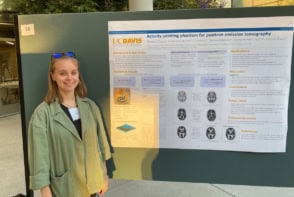
A round-up of the latest international patent applications in radiation therapy.
MRI-PET radiotherapy system verifies dose deposition
Alberta Health Services has devised a radiotherapy system that can determine the in vivo dose deposition of a treatment beam in real time (WO/2018/023195). The system includes a bi-planar MRI apparatus, comprising a pair of magnets with a hole in the centre of one of them. The beam source is positioned to transmit the treatment beam through the hole in the magnet, while a patient support positions the patient so that the treatment target is proximal to the beam. The set-up also includes a PET detector between the magnets, positioned so that the target lies between opposing portions of the detector. The PET detector uses annihilation photons generated when the treatment beam interacts with the patient (either directly, for proton beams, or from an injected radiotracer, for photons) to obtain dose information.
Focused ultrasound modulates peripheral nerves
Researchers from Columbia University have developed techniques for modulating peripheral nerves using focused ultrasound (FUS). In patent application WO/2018/022902, they describe methods for locating a peripheral nerve in a subject using an imaging probe, delivering FUS with one or more ultrasound parameters adjusted to target a location on the peripheral nerve, and modulating the peripheral nerve. The methods can further include eliciting and measuring a physiological response from the FUS modulation, generating tissue deformation in the vicinity of the FUS modulation, and imaging the nerve and tissue deformation simultaneously with the modulation.
Respiratory guidance minimizes normal tissue dose
A team at The Catholic University of Korea has invented a method for obtaining an optimized irradiation time point during radiotherapy, by determining the point in the patient’s respiratory period at which normal tissue is irradiated the least (WO/2018/004052). This is achieved by defining a 3D geometric relationship between peripheral tissue and a target volume, using biological characteristics of normal tissue such as oesophagus or the spine, and an overlap volume histogram. The associated irradiation method involves determining the irradiation timing using the radiation sensitivity of at least one organ within a predetermined distance from the tumour and the degree of geometric overlap between this organ and the tumour. The tumour is then irradiated using this timing, wherein the radiation sensitivity and the geometric overlapping degree may vary according to the patient’s respiration.
Robotic system controls intraoperative radiation therapy
Sensus Healthcare has developed a robotic system for intraoperative radiation therapy (IORT), a treatment that involves irradiation of a tumour bed exposed during surgical excision (WO/2018/013846). The IORT system includes a robotic arm with a number of movable joints and a treatment head, which generates therapeutic X-rays, attached to its distal end. At least one patient motion sensor detects the patient’s breathing movement. A control system dynamically controls the position of the treatment head by varying the position of at least one of the robotic arm’s movable joints. This movement is managed to minimize the relative motion between the treatment head and the internal tumour bed during radiation treatment.
Ultrasound guides partial breast irradiation
A team from The University of Texas System has described devices and methods for 3D volumetric ultrasound guidance of prone partial breast irradiation treatments (WO/2018/023001). In some embodiments, the portable ultrasound apparatus comprises a reservoir with an interior compartment having a central axis and containing a liquid. The reservoir is configured to receive a portion of a patient’s breast into the compartment through an opening. A cradle coupled to the reservoir rotates around its central axis and is also coupled to an ultrasound transceiver such that the transceiver is fixed in at least one degree-of-freedom relative to the cradle. According to the filing, the system provides high-quality volumetric images of breast tissue in treatment planning and patient positioning during radiation treatments.
Motion tracking for focused ultrasound therapy
INSIGHTEC has published details of a method for tracking the motion of a target or other objects of interest in real time during an image-guided treatment procedure such as focused ultrasound (WO/2017/212336). Motion is tracked based upon the comparison of treatment images against a library of reference images, such as MR images, for example. The images are acquired prior to treatment for the anticipated range of motion and processed to identify the location of the target or other object(s) therein. Complementary information associated with the stage of the target motion during treatment is also used for the motion tracking.



